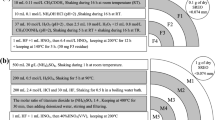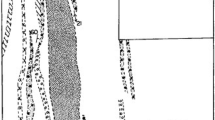Abstract
The test results of the automated mineral identification and characterization system (AMICS), including the mineral composition, particle size distribution, dissemination state and degree of liberation of the target minerals, could be used to improve the beneficiation process. Taking the Dalucao rare earth ore located in Dechang, Sichuan Province, China (with an average content of 2.40 wt%) as the research object in this paper, the chemical composition, phase composition and dissemination state of the minerals were tested by AMICS, and the minerals of different fineness were ground. The concentrate yield, grade and recovery rate of the minerals of different fineness were compared through flotation tests. When the grinding lasted for 5 min and 82.60% of mineral grains passed through the − 74-μm sieve, the yield, grade and recovery rate could reach 20.19%, 8.75% and 73.64%, respectively (as the best grinding fineness), under the same flotation conditions.






Similar content being viewed by others
References
Chakhmouradian AR, Wall F. Rare earth elements: minerals, mines, magnets (and more). Elements. 2012;8(5):333.
Xin L, Xu G. Father of Chinese rare earths chemistry. Bull Chin Acad Sci. 2009;23(2):98.
Shu XC, Liu Y, Li DG. Geochemical characteristics and geological significance of fenites in the Mianning-Dechang REE belt, western Sichuan Province. Acta Petrol Sin. 2019;35(5):1372.
Li Z, Liu Y. Ore types and genesis of weathered deposits in mianning-dechang REE ore belt, Western Sichuan Province, Southwestern China. Earth Sci. 2018;43(4):1307.
Chakhmouradian AR, Smith MP, Kynicky J. From“strategic” tungsten to “green” neodymium: a century of critical metals at a glance. Ore Geol Rev. 2014;64(1):455.
Weng ZH, Jowitt SM, Mudd GM, Haque NA. A detailed assessment of global rare earth element resources: opportunities and challenges. Econ Geol. 2015;110(8):1925.
Hou ZQ, Tian SH, Xie YL. The Himalayan Mianning-Dechang REE belt associated with carbonatite-alkaline complexes, eastern Indo-Asian collision zone, SW China. Ore Geol Rev. 2009;36(1–3):65.
Massari S, Ruberti M. Rare earth elements as critical raw materials: focus on international markets and future strategies. Resour Policy. 2012;38(1):36.
Yl XIE. Ore Genesis and deposit model of carbonatite-host REE deposits: the Mianning-Dechang REE Belt, Western Sichuan province, China. Acta Geol Sin (Engl ed). 2014;88(z2):475.
Liu Y, Chen C, Shu XC. The formation model of the carbonatite-syenite complex REE deposits in the east of Tibetan Plateau: a case study of Dalucao REE deposit. Acta Petrol Sin. 2017;33(7):1978.
Ling XX, Li QL, Liu Y. In situ SIMS Th-Pb dating of bastnaesite: constraint on the mineralization time of the Himalayan Mianning-Dechang rare earth element deposits. J Anal atom Spectrom. 2016;31(8):1680.
Niu HC, Shan QA, Chen XM. Relationship between light rare earth deposits and mantle processes in Panxi rift, China. SCI China Ser D-Earth Sci. 2003;46(1):41.
Guo DX, Liu Y. Occurrence and geochemistry of Bastnasite in carbonatite-related REE deposits, Mianning-Dechang REE belt, Sichuan Province, SW China. ORE Geol Rev. 2019;107:266.
Ouyang H, Liu Y. REE mineralization and characteristics of wall rocks in the muluozhai REE deposit, mianning county, Sichuan Province. Acta Geosci Sin. 2018;39(3):329.
Li XY. Geological characteristics of Dalucao REE deposit in Dechang County, Sichuan Province. Miner Depos. 2005;24(2):151.
Xiong WL, Deng J, Chen BY. Flotation-magnetic separation for the beneficiation of rare earth ores. Miner Eng. 2018;119:49.
Fandrich R, Gu Y, Burrows D, Moeller K. Modern SEM-based mineral liberation analysis. Int J Miner Process. 2007;84(1–4):310.
Liu Y. Chemical and mineralogical study on bastnaesite: dominated rare earth ores. Chem Eng Trans. 2017;59:973.
Tian Y, Liu TA, Zhang GZ, Lv S, Zhou GQ. Kinetics of indium dissolution from marmatite with high indium content in pressure acid leaching. Rare Met. 2017;36(1):69.
Deng ZB, Tong X, Valdivieso AL, Wang X, Xie X. Collectorless flotation of marmatite with pine oil. Rare Met. 2017;36(2):147.
Li YR, Xiong QH. A cross-field exploration of information technology and materials science. InfoMat. 2019;1(1):4.
Zhang Y, Lin H, Dong YB, Xu XF, Wang X, Gao YJ. Coupling relationship between multicomponent recovery of rare earth tailings. Rare Met. 2017;36(3):220.
Ying G. Automated scanning electron microscope based mineral liberation analysis. J Min Mater Charact Eng. 2003;2(1):33.
Fang MS, Wang MY. Application of AMICS in comprehensive recovery of associated gold and silver in a copper ore. Mining Metall. 2018;27(3):104.
Xu CL, Zhong CB, Lyu RL. Process mineralogy of Weishan rare earth Ore by MLA. J Rare Earth. 2019;3:334.
Wen LG, Zeng PS, Zhan XC, Fan CZ, Sun DY, Wang G, Yuan JH. Application of the automated mineral identification and characterization system (AMICS) in the Identification of rare earth and rare minerals. Rock Miner Anal. 2019;37(2):121.
Zhang ZY, He ZY, Yu JX, Xu ZG, Chi RA. Novel solution injection technology for in situ leaching of weathered crust elution-deposited rare earth ores. Hydrometallurgy. 2016;164:248.
Zhang N, Li HX, Cheng HJ, Liu XM. Electron probe microanalysis for revealing occurrence mode of scandium in Bayer red mud. Rare Met. 2017;36(4):295.
Zhang ZY, Sun NJ, He ZY, Chi RA. Local concentration of middle and heavy rare earth elements on weathered crust elution-deposited rare earth ores. J Rare Earths. 2018;36(5):552.
Cox C, Kynicky J. The rapid evolution of speculative investment in the REE market before, during, and after the rare earth crisis of 2010–2012. Extr Ind Soc. 2018;5(1):8.
Kynicky J, Smith MP, Cheng X. Diversity of rare earth deposits: the key example of china. Elements. 2012;8(5):361.
Xu C, Kynicky J, Chakhmouradian AR, Li XH, Song WL. A case example of the importance of multi-analytical approach in deciphering carbonatite petrogenesis in South Qinling orogen: Miaoya rare-metal deposit, central China. Lithos. 2015;227:107.
Wei J, Chu X, Sun XY, Xu K, Deng HX, Chen JG, Wei ZM, Lei M. Machine learning in materials science. InfoMat. 2019;1:338.
Chi RA, Wang DZ. Rare Earth Mineral Processing. Beijing: Science Press. 2014. 1.
Feng M, Cheng X, Kynicky J, Zeng L, Song WL. Rare earth element enrichment in palaeoproterozoic fengzhen carbonatite from the North China block. Int Geol Rev. 2016;58(15):1940.
Acknowledgements
This study was financially supported by the Science and Technology Support Project in Sichuan (No. 2017GZ0400))
Author information
Authors and Affiliations
Corresponding author
Rights and permissions
About this article
Cite this article
Jiao, Y., Qiu, KH., Zhang, PC. et al. Process mineralogy of Dalucao rare earth ore and design of beneficiation process based on AMICS. Rare Met. 39, 959–966 (2020). https://doi.org/10.1007/s12598-020-01446-w
Received:
Revised:
Accepted:
Published:
Issue Date:
DOI: https://doi.org/10.1007/s12598-020-01446-w




